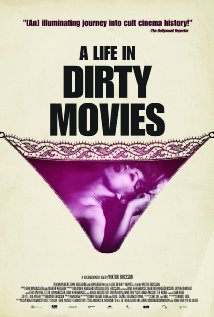
THE SARNOS: A LIFE IN DIRTY MOVIES
Sweden, 2013, 80 minutes, Colour.
Joseph W. Sarno, Peggy Steffans, Michael Bowen, Michael Raso, Matthew Sarno, Annie Sprinkle, John Waters.
Directed by Wiktor Ericsson.
This is a portrait and a biography of film director, Joseph W. Sarno, and his wife of many decades, Peggy Steffans. It was made during 2012 – 2013 in what turned out to be the last months of Sarno’s life, his dying at the age of 89.
Sarno began making films in the 1950s, Sexploitation films, rather than the explicit pornography which was to develop in later decades. Sexploitation seems the correct title whether people judge the films as pornographic or not.
Quite a number of talking heads appear in the film, especially historians, curators of film, Sarno’s producer, his editor, and his son. Prominent director, John Waters, also appears with his characteristic insights and comments, always the touch of humorous irony.
For those interested in the history of cinema, especially in the United States and, with extension to Sweden, the film is of interest whether Sarno and his work are approved of or not. The director himself is quite frank about his films, about how sex films are made, are to be well-written, with some plot and characterisation rather than blunt action. We see the director in his late 80s, reminiscing about his life and films, his intention to make the films he wanted, not watching other exploitation films, but also conscious of what audiences wanted.
His earliest films are in black and white, with quite striking photography and lighting. Sarno and his wife were interested in Ingmar Bergman’s films and there are echoes of his style and lighting. However, with the arrival of a number of makers of sex films, the transition to colour, his later films appear somewhat gaudy and tend to pander to audience curiosity. John Waters reminds audiences of restrictions in the past and how the films of the 50s and 60s caught the attention of younger audiences like himself.
Sarno, at this time, is wanting to make a new film, has written it, has shown it to the money people who feel that there is no profit in it, especially with computers and downloading. And his wife has to explain to him that some of his dramatic devices, like middle-class women in the 21st century ringing each other from phone booths and his not realising that he had to include cellphones.
One of the interesting features is that the Sarnos went to Sweden in the 1960s and began to make films there, liking Sweden so much that they returned year by year, had a house there, which served as a kind of domestic Museum for all the aspects of their films.
Whether you agree with him or not, Joe Sarno is quite a genial character. The film is also a portrait of his wife Peggy, with some flashback material, and her not appearing in the films as a sex actor, but supporting her husband, designing the costumes for the films. She is a strong-minded character, looking after her husband in his old age, shielding him from financial realities, concerned about his health, caring for him, going to visit her almost-100-year-old mother who had initially disliked Sarno, and not seen his films, but had got used to her daughter being with him. There could have been more of her because she is an interesting inarticulate character.
Sarno is gratified that at the end of his life he has had some recognition. He and Peggy are welcome to*retrospective in London at the British film Institute and the National Theatre. And when he dies, Peggy happily displays the large obituary at the top of the page in the New York Times.
There had been a documentary in 2011, Sarno and his Sexual Obsession.